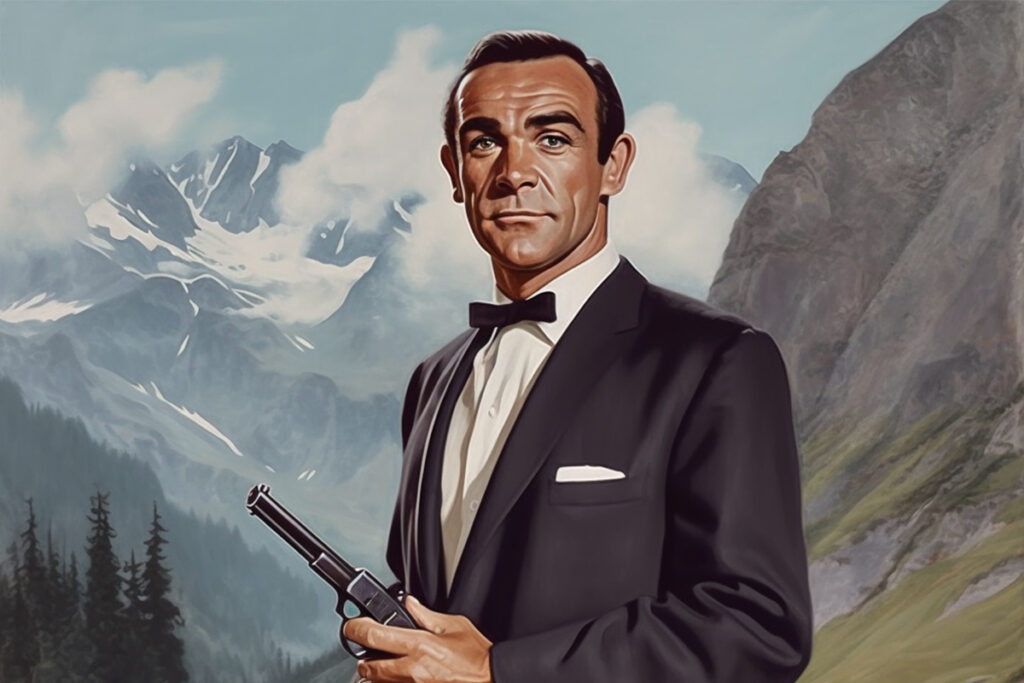Ian Fleming is a name that is synonymous with the world’s most popular spy character, James Bond. The author wrote novels and additional short stories featuring the British secret agent, which have been adapted into countless films and spin-off books. In this article, we take a closer look at Fleming’s literary contributions and guide you through his best works, detailing the inspiration for the books, their themes, and their impact on the James Bond series as a whole.

The Origins of James Bond: Ian Fleming’s Inspiration
To truly understand the impact of Ian Fleming’s work, it’s important to know the story behind the iconic character of James Bond. Born in 1908, Ian Fleming was a journalist, naval intelligence officer, and author. It was the latter that cemented his place in literary history. As a young boy, Fleming was fascinated by the world of espionage and adventure stories, and after a stint in military intelligence during World War II, he was inspired to create a character that embodied the ideals of a British hero.
When it came to naming his character, Fleming chose the most unassuming name possible: James Bond. He also drew on names from the author of the birdwatching book on his shelf. It was with this unassuming name that Fleming began his journey creating the world’s most famous spy.
Ian Fleming’s Life and Career
Before delving into his literary works, it’s important to understand the life and career of Ian Fleming. Born to a wealthy family, Fleming attended Eton College and later studied at Sandhurst Military Academy. After college, he traveled extensively and worked as a stockbroker and journalist before joining the British Naval Intelligence Division during World War II. His time in the division allowed him to see firsthand the thrill and danger of espionage and inspired his work.
After the war, Fleming pursued his writing career in earnest. He began by writing a series of other novels before he eventually created James Bond. His first novel in the series, Casino Royale, was published in 1953 and introduced the world to the character of James Bond.
The Birth of the Iconic Spy Character
Casino Royale introduced readers to James Bond, an agent for MI6 who was tasked with taking down a Russian spy. The character quickly became a cultural icon, and Fleming continued to write Bond novels for the next decade until his death in 1964.
One of the defining features of James Bond is his magnetism. He’s a man who oozes charisma, has a way with women, and is constantly finding himself in dangerous situations. Fleming painted him as the ultimate British hero, a man who always does what is right, no matter how difficult. But it’s not just Bond’s actions that define him; it’s his inner workings, too. Fleming gave readers a glimpse into Bond’s thoughts and feelings, making him a complex and relatable character despite his larger-than-life persona.
James Bond’s character was inspired by many real-life people and events. Fleming drew on his own experiences in the intelligence world, as well as those of his colleagues and friends. He also took inspiration from other famous spies, such as Sidney Reilly and William Stephenson. Additionally, Fleming was known to frequent casinos and was fascinated by the world of high-stakes gambling, which is why many of Bond’s adventures take place in casinos.
Another aspect of Bond’s character that sets him apart from other literary heroes is his love of gadgets. Fleming was a gadget enthusiast himself and used his knowledge to create a range of unique and exciting gadgets for Bond to use in his adventures. From the iconic Aston Martin DB5 to the exploding toothpaste, Bond’s gadgets were as much a part of his character as his charm and bravery.
Despite Bond’s popularity, the character has faced criticism over the years for his portrayal of women. Many critics argue that Bond’s treatment of women is sexist and outdated. However, others argue that Bond’s relationships with women are a reflection of the time in which the novels were written and that the character has evolved over the years to become more respectful of women.
Regardless of the criticism, there’s no denying the impact that James Bond has had on popular culture. From the countless film adaptations to the millions of books sold, Bond has become a cultural icon and a symbol of British heroism. And it’s all thanks to the imagination and creativity of Ian Fleming.
The Classic Bond Novels: A Closer Look
Now it’s time to dive into Fleming’s best works. These novels are considered classics for a reason, and each one offers something unique to the Bond series. In this article, we’ll take a closer look at the four novels that set the stage for the iconic character of James Bond and made him a household name.
Casino Royale: The First Bond Adventure
The first novel in the series, Casino Royale, was published in 1953 and introduced readers to the world of James Bond. The novel follows Bond as he travels to a casino to take down a Russian spy who is funding communist organizations with stolen funds. With its high-stakes games of baccarat, tense spy gameplay, and the introduction of Bond’s love interest, Vesper Lynd, this novel is a must-read for Bond fans.
But what many readers may not know is that the inspiration for Casino Royale came from Fleming’s own experiences as a spy during World War II. Fleming was tasked with coming up with a plan to take down a Nazi spy who was operating in a casino in Estoril, Portugal. This experience served as the inspiration for the novel’s thrilling casino scenes and provided Fleming with firsthand knowledge of the world of espionage.
From Russia with Love: A Cold War Thriller
Published in 1957, From Russia with Love takes Bond to Istanbul, where he is tasked with intercepting a Soviet decoding machine. This novel is a thrilling spy story that showcases Fleming’s deft hand at storytelling. But what sets this novel apart is the addition of an unexpected twist that keeps readers on the edge of their seats until the very end.
One interesting fact about this novel is that it was reportedly one of President John F. Kennedy’s favorite books. In fact, Kennedy is said to have named From Russia with Love as one of his top ten favorite books of all time, which helped to boost the popularity of the Bond series in the United States.
Goldfinger: The Ultimate Heist
Published in 1959, Goldfinger brings Bond to the world of gold smuggling and introduces one of the most iconic villains of the series, Auric Goldfinger. Fleming’s writing shines in this novel, which features a spectacular heist, a big showdown, and the heartbreaking death of a key character.
Interestingly, the character of Goldfinger was based on a real-life gold smuggler named Erno Goldfinger. Fleming was inspired to create the character after reading a newspaper article about Goldfinger’s illegal activities. However, Goldfinger was reportedly not pleased with the use of his name and threatened to sue Fleming. In response, Fleming added a note to the beginning of the novel stating that “the villain of this book is not named after the architect whose plans are now before you.”
Thunderball: A Race Against Time
Published in 1961, Thunderball is a quintessential Bond novel, featuring everything from beautiful women and deadly sharks to a race against the clock to stop a nuclear weapon from exploding. This novel is an action-packed thrill ride that never slows down. Families at the time protested against the way that the novel tried to ensnare their younger members into buying bonds for the adult pension fund, and this subtext fed into the plot.
One interesting fact about Thunderball is that it was originally meant to be a screenplay for a Bond film. However, when the film plans fell through, Fleming decided to turn the screenplay into a novel instead. The novel was a huge success and helped to cement Bond’s place in popular culture.
So there you have it, a closer look at the classic Bond novels that helped to shape the world of espionage fiction. Whether you’re a die-hard Bond fan or a newcomer to the series, these novels are must-reads that are sure to thrill and entertain.
The Evolution of Bond: Changes in Style and Tone
As the Bond series progressed, so too did Fleming’s writing style. The later novels in the series offer a different tone and tackle more complicated themes than the earlier ones. These novels show that Fleming was not content to rest on his laurels and had more to say with the Bond character.
On Her Majesty’s Secret Service: A Personal Mission
On Her Majesty’s Secret Service features one of Bond’s most personal missions yet. The novel sees Bond fall in love, finally giving readers a glimpse into his more vulnerable side. Fleming’s writing here is more introspective, allowing readers to delve deeper into Bond’s psyche.
You Only Live Twice: Exploring Bond’s Dark Side
You Only Live Twice takes Bond to Japan, where he battles a criminal organization threatening world peace. This novel is darker in tone than previous Bond novels, exploring themes of depression and grief following a major loss for the character. Fleming’s writing here is rawer and more emotional, making this a standout novel in the series.
The Man with the Golden Gun: A Final Showdown
The Man with the Golden Gun sees Bond take on his ultimate nemesis, the titular villain, Francisco Scaramanga. This novel is more action-packed than the previous two and offers a satisfying conclusion to the Bond series. Through it, Fleming showcases his ability to weave together complex plots while keeping the reader engaged and on the edge of their seats.
The Bond Legacy: Spin-offs and Continuations
The legacy of Ian Fleming’s work continues to this day, with numerous spin-off novels and films based on his character. But it wasn’t just adaptations of his work that became popular; other authors took up the mantle of writing Bond stories, continuing and expanding on Fleming’s legacy.
Kingsley Amis and Colonel Sun: A New Author Takes the Reins
Kingsley Amis was a fan of the Bond novels and was approached to write one himself after Fleming’s death. The result was Colonel Sun, which sees Bond facing off against a villainous Chinese official. Amis’ novel follows in the footsteps of Fleming and is a worthy addition to the Bond series.
John Gardner’s Bond: A Modern Interpretation
John Gardner was another author who took up the mantle of writing Bond stories. He wrote 14 original Bond novels, each updating the character for the modern era. His writing style is more action-packed and fast-paced than Fleming’s, but it still captures the thrill and danger that made the Bond series so popular in the first place.
Raymond Benson’s Contributions to the Bond Saga
Raymond Benson is the author who wrote the most Bond novels following Gardner’s reign. His additions to the Bond series include Bond’s origin story in The Man with the Red Tattoo and his final novel, The Man with the Sword. Of all the Bond authors, Benson’s works are notable for being the most literary and for exploring the psychology and interpersonal relationships of the characters.
The Best of Bond
Ian Fleming’s contributions to the James Bond series cannot be overstated. His writing style, themes, and characterization defined the spy genre and created a cultural icon that endures to this day. While all of his novels are worth reading, the best of Bond can be found in his early works: Casino Royale, From Russia with Love, Goldfinger, and Thunderball.
The Bond legacy continues to thrive thanks to the works of authors like Kingsley Amis, John Gardner, and Raymond Benson. These authors have kept the legacy of Ian Fleming alive, ensuring that the world’s most famous spy will continue to captivate audiences for generations to come.
FAQs
What is Ian Fleming famous for?
Ian Fleming is best known for writing the famous James Bond series.
Who is James Bond?
James Bond is a fictional MI6 agent, a British intelligence officer working under the code name 007. He is one of the most famous book and film characters of all time and remains an icon of British media.
When was Ian Fleming writing?
Fleming wrote during the 1950s and 1960s. The first book was released in 1953 and the last in 1964. Some of the themes and characters used in these books are now deemed outdated.
- The 11 Best Books About Cats You Should Read - January 16, 2024
- The 9 Best Books on Building Confidence - January 16, 2024
- Discover the 10 Best Books on the Brain - January 16, 2024



